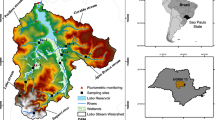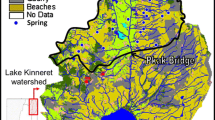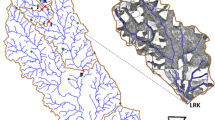Abstract
This paper presents a hydrological and water quality model for Cherry Creek watershed, located in southeastern Kansas, USA. The Cherry Creek catchment drains approximately 88220 ha and it is a main contributor of water to the Neosho River. Hydrological modeling of the Cherry Creek watershed is performed using the Hydrological Simulation Program Fortran (HSPF). Simulated results for total ammonia (TAM) concentrations occurring at the Cherry Creek watershed outlet for four land use scenarios and a 2-year simulation period, are presented. Sensitivity analysis of total ammonia estimations (TAM=NH3+NH4) to the unbounded HSPF parameter POTFW is subsequently presented. POTFW represents the ratio of a water quality constituent yield to sediment wash-off outflow. Results showed that small perturbations to a 50 mg/Kg POTFW base value produce the largest normalized sensitivities. Peak sensitivities reached up to 248%, with the -1% perturbation producing the most dramatic sensitivity response in TAM estimations. Results showed a strong relationship between normalized sensitivities to river flow regime. Non-linearities in sensitivity for small ±1% perturbations were detected. These non-linearities are more evident for high stream flow values (strong flood events). For larger perturbations (±60%, ±40%, ±20%, and ±5%) the sensitivity response was shown to be linear.
Access this chapter
Tax calculation will be finalised at checkout
Purchases are for personal use only
Preview
Unable to display preview. Download preview PDF.
Similar content being viewed by others
References
Manders, G.C., Aber, J.S.: Tri-State Mining District legacy in northeastern Oklahoma. Emporia State Research Studies 49(2), 29–51 (2014). http://academic.emporia.edu/esrs/vol49/manders_aber.pdf
Grand Lake O’ the Cherokees Watershed Alliance Foundation, 2008. Grand Lake Watershed Plan: For improving water quality throughout the Grand Lake Watershed. Draft. http://www.ok.gov/conservation/documents/Grand_Lake_%20WBP_DRAFT.pdf
Kansas Center for Agricultural Resources and the Environment. Middle Neosho Watershed Restoration and Protection Strategy, final draft plan (2011). http://www.kswraps.org/files/attachments/middleneosho_plansummary.pdf
Alarcon, V.J., Hara, C.G.: Scale-Dependency and Sensitivity of Hydrological Estimations to Land Use and Topography for a Coastal Watershed in Mississippi. In: Taniar, D., Gervasi, O., Murgante, B., Pardede, E., Apduhan, B.O. (eds.) ICCSA 2010, Part I. LNCS, vol. 6016, pp. 491–500. Springer, Heidelberg (2010)
EPA. Better Assessment Science Integrating Point and Nonpoint Sources (BASINS) (2013). http://water.epa.gov/scitech/datait/models/basins/index.cfm
Bicknell, B.R., Imhoff, J.C., Kittle Jr., J.L., Donigian Jr., A.S., Johanson, R.C.: Hydrological Simulation Program – FORTRAN, User’s Manual for Version 11 (1997)
Lent, M., McKee, L.: Guadalupe River Watershed Loading HSPF Model: Year 3 final progress report. San Francisco Estuary Institute. Richmond, Califormia (2011). http://www.sfei.org/sites/default/files/Guad_HSPF_Model__forSPLRev_17Feb2012.pdf
Deliman, P.N., Pack, W., Nelson, E.J.: Integration of the Hydrology Simulation Program—FORTRAN (HSPF) WatershedWater Quality Model into the Watershed Modeling System (WMS). Technical Report W-99-2, September 1999, US Army Corps of Engineers (1999)
Tetra Tech, Inc. Appendix VII: LSPC Watershed Model Development for Simulation of Loadings to the Los Angeles/Long Beach Harbors. Prepared for: USEPA Region 9 Los Angeles Regional Water Quality Control Board (October 2010). http://www.waterboards.ca.gov/losangeles/board_decisions/basin_plan_amendments/technical_documents/66_New/10_1217/
Jobes, T.H., Kittle, Jr. J.L., Bicknell, B.R.: A Guide to Using Special Actions in the Hydrological Simulation Program—FORTRAN (HSPF). AQUA TERRA Consultants (1999). ftp://hspf.com/hspf/Special_actions_v11.doc
Brown, L.C., Barnwell, T.O.: The enhanced stream water quality models QUAL2E and QUAL2E-UNCAS: documentation and user manual. Env. Res. Laboratory. US EPA, EPA /600/3-87/007, Athens, GA. p. 189 (1987)
North Carolina Department of Environment and Natural Resources, NCDECNR. Falls Lake Nutrient Response Model: Final Report. Modeling & TMDL Unit, Division of Water Quality, North Carolina Department of Environment and Natural Resources (2009). http://portal.ncdenr.org/c/document_library/get_file?uuid=33debbba-5160-4928-9570-55496539f667&groupId=38364
KDHE. Guidelines for investigating and remediating nitrate/ammonia contamination from agricultural chemical releases. Kansas Bureau of Environmental Remediation/Remedial Section Policy. BER policy # BER-RS-050 (January 2007). http://www.kdheks.gov/ber/policies/BER_RS_50.pdf
Author information
Authors and Affiliations
Corresponding author
Editor information
Editors and Affiliations
Rights and permissions
Copyright information
© 2015 Springer International Publishing Switzerland
About this paper
Cite this paper
Alarcon, V.J., Sassenrath, G.F. (2015). Sensitivity of Nutrient Estimations to Sediment Wash-off Using a Hydrological Model of Cherry Creek Watershed, Kansas, USA. In: Gervasi, O., et al. Computational Science and Its Applications -- ICCSA 2015. ICCSA 2015. Lecture Notes in Computer Science(), vol 9157. Springer, Cham. https://doi.org/10.1007/978-3-319-21470-2_33
Download citation
DOI: https://doi.org/10.1007/978-3-319-21470-2_33
Published:
Publisher Name: Springer, Cham
Print ISBN: 978-3-319-21469-6
Online ISBN: 978-3-319-21470-2
eBook Packages: Computer ScienceComputer Science (R0)




